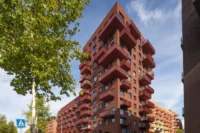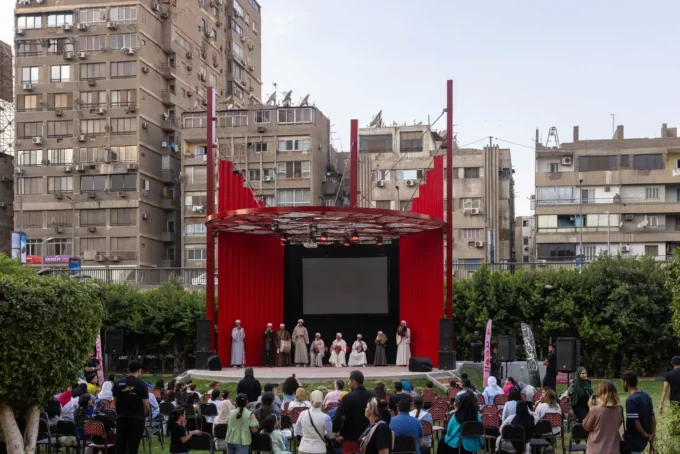Blending history, ecology, and technology, the Dingzhou Cultural and Sports Center by THAD represents a bold and comprehensive vision for urban regeneration in a city steeped in over a thousand years of cultural heritage. Set just three kilometers from the iconic Song Dynasty Tower in the ancient city of Dingzhou—hailed by the United Nations as a “Millennium County”—this project is not merely an urban development; it is a symbol of renewal, a regional catalyst, and a contemporary ode to heritage.
Occupying 14.05 hectares with a gross floor area of over 136,000 square meters, the Center acts as the civic core of Dingzhou’s new ecological region—an area strategically positioned to drive forward the city’s evolution through Culture, Ecology, Technology, and Industry. It also serves as a vital implementation platform for the Beijing-Tianjin-Hebei Collaborative Development “Micro-Center” Strategy, ensuring Dingzhou’s integration into broader regional development ambitions.

City-Park Integration: Planning with Nature at the Forefront
Central to the project is a deep integration of urban and ecological planning. Through a deliberate north-south site organization, the five main structures—the Theater, Cultural Center, Stadium, Fitness Center, and Exhibition Center—are grouped into a harmonious layout that embraces a central landscape. This design ensures a seamless connection to the adjacent southern park, allowing nature to flow into the urban core.
The architecture responds dynamically to Dingzhou’s seasonal climate. In winter, the building masses buffer cold northeastern winds, while in summer, the lake and surrounding greenery cool prevailing southwestern breezes, creating a comfortable microclimate. This city-park integration not only enhances environmental performance but also frames a new identity for Dingzhou as an ecological model city.

The “Wandering Cloud” Roofscape: A Poetic Structural Identity
One of the defining architectural elements of the complex is the “Wandering Cloud” roof—a parametric structure that stretches fluidly across the site, linking all five major buildings through connective second-floor walkways. The design generates multi-layered, multi-functional urban spaces that encourage exploration, gathering, and spontaneous use.
Supported by tree-like steel columns, the expansive roof features aluminum panels and mesh ceilings with gradients of perforation and color, reflecting the iridescent texture of Dingzhou’s historic white porcelain. At once lightweight and expressive, this roofscape acts as a symbolic gesture, echoing both the natural environment and the millennia-old craft traditions of the region.
At its zenith stands the Garden Expo Tower, offering panoramic views across the city and a visual link to Dingzhou’s ancient tower. This creates a powerful dialogue between past and present, anchoring the site within both historical memory and a forward-looking urban identity.

Civic Engagement Through Public Co-Design
Understanding that architecture must grow from the voices of those it serves, the design process embraced a co-design philosophy. Students from Dingzhou No.1 High School were invited to visualize their dreams for the future of their city—transforming the design into a community project that fosters emotional investment and civic pride.
This participatory approach reframed the project not merely as spatial renewal, but as a collective act of belonging. It positions citizens as both co-creators and future stewards of their public realm, setting a powerful precedent for inclusive urbanism.

Empowered by Technology and Sustainability
The project seamlessly blends poetic design with cutting-edge digital fabrication and low-carbon strategies. Parametric modeling enabled the optimization of complex curved surfaces, while BIM and CNC technologies ensured the efficient realization of intricate steel and curtain wall systems.
Sustainable energy systems are embedded throughout: solar panels and air-source heat pumps provide over 80% of hot water needs, cutting carbon emissions by over 22 tons annually. Energy-efficient lighting contributes an additional 204 tons of annual CO₂ savings, while the site’s 46,459 sqm of green space sequesters over 160 tons of carbon each year.

Operation and Cultural Vitality
Since opening in 2024, the Dingzhou Cultural and Sports Center has rapidly become a vibrant community destination and cultural landmark. It has hosted large public events including National Day drone shows, Lantern Festival celebrations, and major sporting tournaments such as the 2024 CBA Club Cup and the Chinese Women’s Volleyball Super League.
The Cultural Center hums with activity—youth studying, exhibitions opening, and performances ranging from avant-garde theater to Hebei Bangzi opera. The National Fitness Center became the city’s second-largest gym within two months of opening, while the Convention & Exhibition Center now anchors regional industry events like the Dingzhou Sports Goods Industry Conference and the Auto Culture Expo, reinforcing the city’s emerging economic engine.
A Bridge Between Centuries
The Dingzhou Cultural and Sports Center is more than a building—it is a living stage where history meets innovation, community meets creativity, and city meets nature. It offers a vital civic anchor for a city poised for transformation, and a poetic template for how future urban developments might integrate ecological wisdom, technological intelligence, and deep cultural roots.
Photography: Xia Zhi
- Architecture as cultural infrastructure
- Beijing-Tianjin-Hebei Micro-Center
- CBA and cultural event venues
- City-park integration design
- Community co-design in architecture
- Cultural hub urban regeneration
- Digital fabrication architecture China
- Dingzhou Cultural and Sports Center
- Dingzhou urban transformation
- Ecological urban planning China
- Green public architecture
- Heritage-inspired modern architecture
- Multi-functional civic complex
- Participatory urban development
- Porcelain-inspired roof design
- Smart ecological city planning
- Solar-powered public buildings
- Sustainable civic architecture
- THAD architecture projects
- Wandering Cloud parametric roof


































Leave a comment